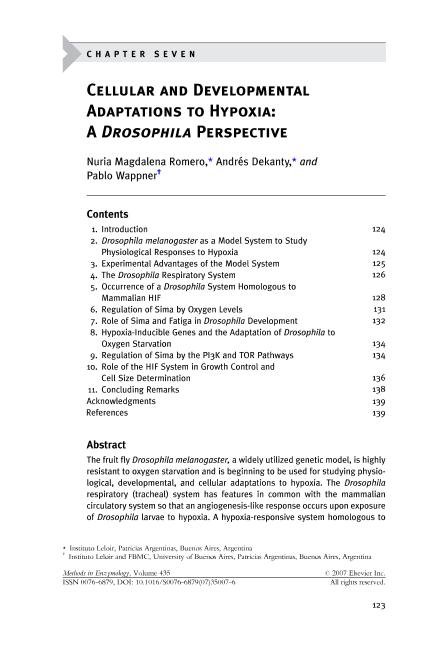Mostrar el registro sencillo del ítem
dc.contributor.author
Romero, Nuria Magdalena

dc.contributor.author
Dekanty, Andres

dc.contributor.author
Wappner, Pablo

dc.date.available
2017-12-28T19:30:21Z
dc.date.issued
2007-12
dc.identifier.citation
Wappner, Pablo; Dekanty, Andres; Romero, Nuria Magdalena; Cellular and developmental adaptations to hypoxia: a Drosophila perspective; Elsevier Academic Press Inc; Methods In Enzymology.; 435; 12-2007; 123-144
dc.identifier.issn
0076-6879
dc.identifier.uri
http://hdl.handle.net/11336/31870
dc.description.abstract
The fruit fly Drosophila melanogaster, a widely utilized genetic model, is highly resistant to oxygen starvation and is beginning to be used for studying physiological, developmental, and cellular adaptations to hypoxia. The Drosophila respiratory (tracheal) system has features in common with the mammalian circulatory system so that an angiogenesis-like response occurs upon exposure of Drosophila larvae to hypoxia. A hypoxia-responsive system homologous to mammalian hypoxia-inducible factor (HIF) has been described in the fruit fly, where Fatiga is a Drosophila oxygen-dependent HIF prolyl hydroxylase, and the basic helix-loop-helix Per/ARNT/Sim (bHLH-PAS) proteins Sima and Tango are, respectively, the Drosophila homologues of mammalian HIF-alpha (alpha) and HIF-beta (beta). Tango is constitutively expressed regardless of oxygen tension and, like in mammalian cells, Sima is controlled at the level of protein degradation and subcellular localization. Sima is critically required for development in hypoxia, but, unlike mammalian model systems, it is dispensable for development in normoxia. In contrast, fatiga mutant alleles are all lethal; however, strikingly, viability to adulthood is restored in fatiga sima double mutants, although these double mutants are not entirely normal, suggesting that Fatiga has Sima-independent functions in fly development. Studies in cell culture and in vivo have revealed that Sima is activated by the insulin receptor (InR) and target-of-rapamycin (TOR) pathways. Paradoxically, Sima is a negative regulator of growth. This suggests that Sima is engaged in a negative feedback loop that limits growth upon stimulation of InR/TOR pathways
dc.format
application/pdf
dc.language.iso
eng
dc.publisher
Elsevier Academic Press Inc

dc.rights
info:eu-repo/semantics/openAccess
dc.rights.uri
https://creativecommons.org/licenses/by-nc-sa/2.5/ar/
dc.subject
Hypoxia
dc.subject
Drosophila
dc.subject
Adaptation
dc.subject
Hif
dc.subject.classification
Otras Ciencias Biológicas

dc.subject.classification
Ciencias Biológicas

dc.subject.classification
CIENCIAS NATURALES Y EXACTAS

dc.title
Cellular and developmental adaptations to hypoxia: a Drosophila perspective
dc.type
info:eu-repo/semantics/article
dc.type
info:ar-repo/semantics/artículo
dc.type
info:eu-repo/semantics/publishedVersion
dc.date.updated
2017-12-12T20:04:02Z
dc.identifier.eissn
1557-7988
dc.journal.volume
435
dc.journal.pagination
123-144
dc.journal.pais
Estados Unidos

dc.journal.ciudad
New York
dc.description.fil
Fil: Romero, Nuria Magdalena. Consejo Nacional de Investigaciones Científicas y Técnicas. Oficina de Coordinación Administrativa Parque Centenario. Instituto de Investigaciones Bioquímicas de Buenos Aires. Fundación Instituto Leloir. Instituto de Investigaciones Bioquímicas de Buenos Aires; Argentina
dc.description.fil
Fil: Dekanty, Andres. Consejo Nacional de Investigaciones Científicas y Técnicas. Oficina de Coordinación Administrativa Parque Centenario. Instituto de Investigaciones Bioquímicas de Buenos Aires. Fundación Instituto Leloir. Instituto de Investigaciones Bioquímicas de Buenos Aires; Argentina
dc.description.fil
Fil: Wappner, Pablo. Consejo Nacional de Investigaciones Científicas y Técnicas. Oficina de Coordinación Administrativa Parque Centenario. Instituto de Investigaciones Bioquímicas de Buenos Aires. Fundación Instituto Leloir. Instituto de Investigaciones Bioquímicas de Buenos Aires; Argentina
dc.journal.title
Methods In Enzymology.

dc.relation.alternativeid
info:eu-repo/semantics/altIdentifier/url/http://www.sciencedirect.com/science/article/pii/S0076687907350076
dc.relation.alternativeid
info:eu-repo/semantics/altIdentifier/doi/http://dx.doi.org/10.1016/S0076-6879(07)35007-6
Archivos asociados
